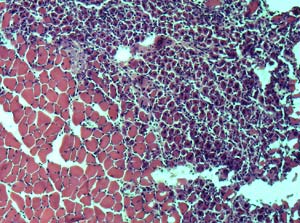June 16, 2008
Making an important step for regenerative medicine, Bioengineering Assistant Professor Irina Conboy has identified two key regulatory pathways that control how well adult stem cells repair and replace damaged tissue.
 Conboy and her team, including lead study author and recent BioE Ph.D. Morgan Carlson, were able to tweak how stem cells reacted to biochemical signals to stimulate muscle tissue in old mice to repair itself nearly as well as the muscle in much younger mice. The research was published June 15 in an advance online issue of the journal Nature.
Conboy and her team, including lead study author and recent BioE Ph.D. Morgan Carlson, were able to tweak how stem cells reacted to biochemical signals to stimulate muscle tissue in old mice to repair itself nearly as well as the muscle in much younger mice. The research was published June 15 in an advance online issue of the journal Nature.
The researchers focused on the interplay of two competing molecular pathways that control the adult stem cells, which sit next to the mature, differentiated cells that make up our working body parts. When the mature cells are damaged or wear out, the stem cells are called into action to begin the process of rebuilding. As we age, chemical signals in the body prevent stem cells from repairing as efficiently.
Conboys group disabled the “aging pathway” of chemical signals in a group of aged mice and compared their muscle regeneration to young mice. They found that the old mice with their aging chemicals supressed showed regeneration comparable to that of the young mice.
Although there is much work still to be done before creating a workable human cures for aging, this research is a major step toward understanding.
Read more at the Berkeley News Center and the San Francisco Chronicle.
